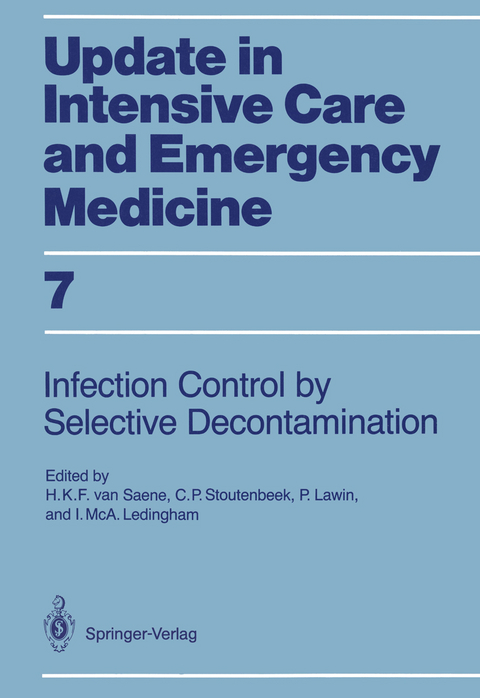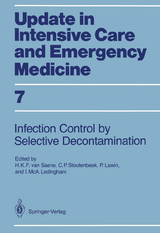Infection Control in Intensive Care Units by Selective Decontamination
Springer Berlin (Verlag)
978-3-540-51041-3 (ISBN)
Selective decontamination is a technique which combines short-term and long-term antimicrobials to prevent or treat the acquisition and subsequent carriage of microorganisms causing late colonization and infections. The antimicrobials are selective in that they leave the indigenous, mostly anaerobic flora more or less intact, whilst the effective decontamination provides a genuine breakthrough in the endogenous route of pathogenesis. The improvements in decontamination techniques presented here offer significant reduction in infection related morbidity and mortality among trauma patients.
Foreword.- One: Pathogenesis.- Host-microorganism Relationship in Healthy People.- Classification of Microorganisms Based on Intrinsic Pathogenicity.- Defence Against Colonization and Infection.- Oropharyngeal/Gastrointestinal Carriage: Role in Endogenous Colonization and Infection.- Discussion.- Host-microorganism Relationship in the Critically Ill.- Impaired Colonization Defence of the Oropharynx.- Impairment of Defence of the Stomach and Intestine against Colonization in the Critically Ill Patient.- Pathogenesis of Colonization/Infection of Lower Airways (Endogenous vs Exogenous): Conventional Approaches to Infection Control.- Discussion.- Two: The Conventional Approach to Infection Control.- Clinical Studies.- Prospective Study of Colonization, Infection and Mortality Rates during Conventional Therapy: Glasgow Data.- Infection and Mortality Rates in Critically Ill Patients during Conventional Antibiotic Regimen.- A Prospective Study of Colonization and Infection in the Neonatal Surgical Unit at Alder Hey Children's Hospital, Liverpool, UK.- Surveillance of Nosocomial Infections in a Surgical ICU: A Prospective Study.- Prospective Study of Colonization, Infection and Mortality Rates during Conventional Therapy.- Infection Control in the ICU: Pattern of Colonization and Infection in Surgical Intensive Care Patients - a Prospective Study.- Discussion.- Antibiotic Resistance.- Where and How does Antimicrobial Resistance Develop in the Critically Ill? Studies in Neonatal Patients.- Do Conventional Policies Control Antibiotic-resistant Bacteria?.- Discussion.- Three: An Alternative Approach - Selective Decontamination of the Digestive Tract (SDD); the Use of Non-absorbable and Parenteral Agents.- Philosophy of SDD.- Concept of Selective Decontamination in theCritically Ill.- Topical Antibiotic Regimen.- Use of a Short-term Parenteral Antibiotic as a Supplement to SDD.- Pharmaceutical Technology, in Selective Decontamination.- Discussion.- Clinical Studies.- Prospective Study of Colonization, Infection and Mortality in ICU Patients Treated with SDD and Systemic Cefotaxime: Glasgow Results.- Prospective Study of Mortality Rates in Critically Ill Patients During SDD Regimen.- Prospective Studies of Colonization, Infection and Mortality Rates: Liverpool Data.- Infection Control by Selective Flora Suppression in Critically Ill Patients.- Prospective Studies of Colonization, Infection and Mortality Rates in ICU Patients Receiving SDD: Ulm Results.- Prevention of Colonization and Subsequent Infection in Critically Ill Patients: a Prospective, Randomized Study.- The Effect of a Novel Regimen of Selective Decontamination on the Incidence of Unit-Acquired Lower Respiratory Tract Infection in Mechanically Ventilated Patients.- Discussion.- Role of Endotoxin.- Significant Reduction of Faecal Endotoxin Pool by Oral Polymyxin E and Tobramycin in Human Volunteers.- Endotoxaemia in Multiple Organ Failure: A Secondary Role for SDD?.- Discussion.- Emergence of Resistance during SDD.- Cefotaxime Combined with Selective Decontamination in Long-Term Intensive Care Unit Patients: Virtual Absence of Emergence of Resistance.- Emergence of Resistance During Selective Decontamination: Glasgow Results.- Changes in Antibiotic Resistance in Tracheal Aspirates Following Selective Decontamination of the Digestive Tract.- The Liverpool Experience, 1987-1988.- Colonization and Resistance Patterns of Microbial Isolates Following SDD in Association with Short-Course Cefotaxime.- Gram-negative Bacillary Resistance in a Surgical Intensive Care Unit: AFour-Year Surveillance.- Discussion.- Four: Stress Ulcer Prophylaxis and Pneumonia.- Stress Ulcer Prophylaxis and Pneumonia.- Pathogenesis of Stress Ulcer Bleeding in the Critically Ill.- Gastric Colonization and Nosocomial Pneumonia in the Mechanically Ventilated Patient.- New Approaches to the Prevention of Infection in Intensive Care Unit Patients.- Discussion.- Five: Analysis of Conventional and SDD Approaches.- A Possible Explanation for the Success of SDD.- Discussion.- Impact of Parenteral Cephalosporins on Human Oropharyngeal and Faecal Flora.- Discussion.- Development of Antibiotic Resistance During Conventional and SDD.- The Gut and Sepsis in the Critically Ill.- Discussion.- Conclusions.- Close.- Appendices.- Appendix I: Formulations Used in Selective Decontamination.- Appendix II: List of Abbreviations.- Appendix III: Trials of Infection Rates Following Conventional Treatment and Selective Decontamination.
| Erscheint lt. Verlag | 17.3.1989 |
|---|---|
| Reihe/Serie | Update in Intensive Care and Emergency Medicine |
| Zusatzinfo | XV, 235 p. 5 illus. |
| Verlagsort | Berlin |
| Sprache | englisch |
| Maße | 170 x 244 mm |
| Gewicht | 435 g |
| Themenwelt | Sachbuch/Ratgeber ► Gesundheit / Leben / Psychologie |
| Medizin / Pharmazie ► Medizinische Fachgebiete ► Intensivmedizin | |
| Schlagworte | Care • Infection • Intensive care • Intensive care unit • Mortality • Multiple Organ Failure • prevention • Sepsis • Trauma |
| ISBN-10 | 3-540-51041-9 / 3540510419 |
| ISBN-13 | 978-3-540-51041-3 / 9783540510413 |
| Zustand | Neuware |
| Haben Sie eine Frage zum Produkt? |
aus dem Bereich




